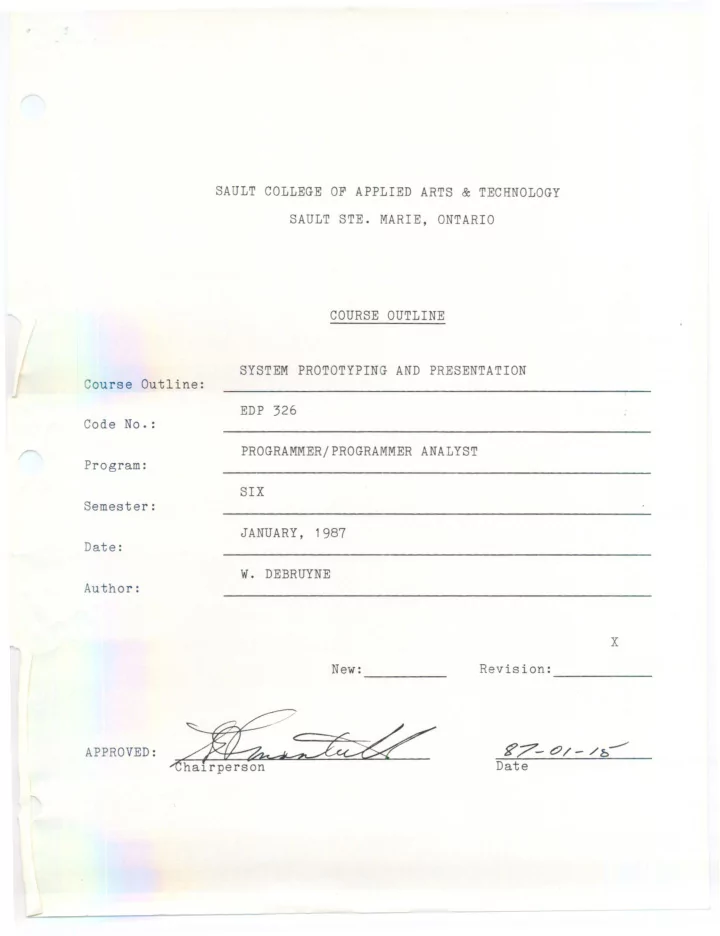

SAULT COLLEGE OF APPLIED ARTS & TECHNOLOGY SAULT STE. MARIE, ONTARIO COURSE OUTLINE SYSTEM PROTOTYPING AND PRESENTATION Course Outline: EDP 326 Code No.: PROGRAMMER/PROGRAMMER ANALYST Program: SIX Semester: JANUARY, 1987 Date: w. DEBRUYNE Author: X New: Revision: ~7- APPROVED: t:J / - / b--- Date ---
- 2 - SYSTEM PROTOTYPING & PRESENTATION EDP 326 Name Course Course Number 5 hours per week TIME: RESOURCE: COBOL MANUALS, POWERHOUSE MANUALS (available for reference in student work room) and TEACHER NOTES. AIM: The course SYSTEM PROTOTYPING & PRESENTATION is a continuation in study of system developmentwhich originatedin the SYSTEM DESIGN AND PRESENTATION course taught in the previous semester. The present course will emphasize prototyping as an active enhancement to the analysis phase. The student will become prepared to handle the design phase of the computerization process of a business information system. Finally, the student will gain a strong working knowledge of the fourth generation language "POWERHOUSE", and make use of OMR technology, and use COBOL on both the PCs and the VAX making the student a viable commodity in the EDP market of today. COURSE SYNOPSIS: Prototyping is a user-involved system development, (an enhancement to the traditional system development process). Computer systems are created virtually on a real-time basis, that is too say a transition is made directly from user requests to computerize implementation of a system that complies with their request. This is accomplished with powerful application software development tools that make it possible to create all the files and application programs needed. - - -
-- _.- - _. - 3 - course will make use of programming tools such as POWERHOUSE on the The VAX 11/780, Optical Mark Reading equipment and COBOL available on the IBM PCs and the VAX. The first part of the course will deal with the development of a micro- computer registration system to be implemented on the various microcomputeI systems in the satellite campuses of Sault College. The screens and reports will be quickly generated using our 4th GL, POWERHOUSE. Once the reports and screen layouts have been approved they will be converted over to the implementation languageof COBOL on the VAX 11/780. Once the syster has been approved, it will be downloaded to the microcomputer system using a communications software package to handle the conversion task. The system will be designed in accordance to the following rules and limitations. Firstly, the COBOL compiler for the micro is very structured and limited in comparison to the VAX COBOL, therefore, you will be require( to follow the manuals for microcomputer COBOL. Also, because the system if to be maintained by the Computer Services Department of Sault College, you will therefore adhere to the programming standards of this department. The project will be completed in groups of three. The best system of all the groups is to be selected by the Computer Services Department and implemented at the satellite campuses. Aside from the marks, the group that had their system selected will receive a letter of recommendation to be placed in their files. At this point in your studies you have had plenty of experience in system design and development, therefore, an added requirement is: after you hav! received all the system specifications for the project, you will submit a tender that will contain the total manhours that your group feels will be required to complete the project and a total monetary charge for your services. You will assume your only cost to be labour. Each group will hand in their hours at the end of each week that will be collected and logged by your instructor. At the completion of the project your actual hours and costs will be compared to your estimated hours and costs. The group with the smallest deviation will obtain 3% (percentage) bonus marks to be added to the overall project mark. The project package must contain the following: 1) Tender 2) File Descriptions 3) Data Element List 4) Source Code with Internal Documentation 5) Screen Layouts 6) Report Layouts 7) User Guide -----------
- 4 - The second project in this course will require the use of the College's ne~ Optical Mark Reader to manipulate response sheets for various applications. The student will be required to perform bit manipulation via the COBOL or FORTRAN programming language to generate statistical reports. The project will give each student great insight into a new data entry device, the OMR. STUDEIT EVALUATION: The student's final grade will consist of the following: @ 1 Test 30% Attitude and @ Participation 5% Two Projects: @ 40% Project 1 @ 25% - Project 2 1"00% - -
Recommend
More recommend